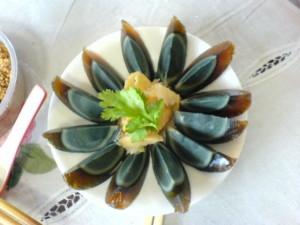 One of the reasons we travel to exotic and faraway locations is for the thrill of adventure. Seeing new sights, experiencing new cultures and, of course, trying new foods all make traveling around the world exhilarating.
One of the reasons we travel to exotic and faraway locations is for the thrill of adventure. Seeing new sights, experiencing new cultures and, of course, trying new foods all make traveling around the world exhilarating.
Each destination has its own unique foods for you to try. But if you’re a real thrill seeker and adventure junkie, there are foods in certain countries and cities that are most certainly not for the faint of heart.
If you are curious and have a serious food bucket list, here are some of the grossest foods around the world.
Scotland
If you find yourself in Scotland, try haggis. This dish contains a sheep’s heart, liver and lungs minced and mixed with onions, oatmeal, suet, salt and spices cooked inside the sheep’s stomach.
Japan
Sure, some sushi and sashimi can be really out there. But did you know you also dine on tuna eyeballs in Japan?
Sweden
While in Sweden, why not try surstromming? It is Baltic Sea herring that has been fermented with just enough salt to prevent it from rotting. It is canned in brine and typically has such a pungent aroma it’s recommended to eat it outside.
Thailand
Get your fill of protein and exotic cuisine by trying jing leed, which translates to grasshoppers. They typically are seasoned with salt, pepper, chili and cooked in a big wok. It’s been reported that its texture is a bit like popcorn, until the juice squirts out when it is bitten into.
Cambodia
Anyone with arachnophobia might want to skip this one. Fried spider is considered a delicacy in Skuon, Cambodia. It’s marinated in MSG, sugar and salt and cooked in garlic. It is a bit meatier than grasshoppers, and has quite a bit more “juice” when it’s bitten into.
Italy
Italy may be known for some seriously stinky cheeses, but this one takes the cake. In Sardinia, look for casu marzu, which literally translates to rotten cheese. It is traditional sheep milk cheese, but cheese makers set this cheese outside and allow cheese flies to lay eggs inside of it. Why? Because the larvae break down the cheese’s fats and ferments it.
China
This, um, delicacy is called 100 or 1,000-year-old egg, century egg or millennium egg. While it’s not exactly that old, it is pretty rotten. An egg is preserved in a mixture of clay, ash and quicklime for a few months. During this time, the yolk turns a dark green or black and slimy, while the egg white turns into a dark brown jelly. It supposedly tastes like a hardboiled egg, the smell is a bit worse though.
Photo from Wikipedia.


